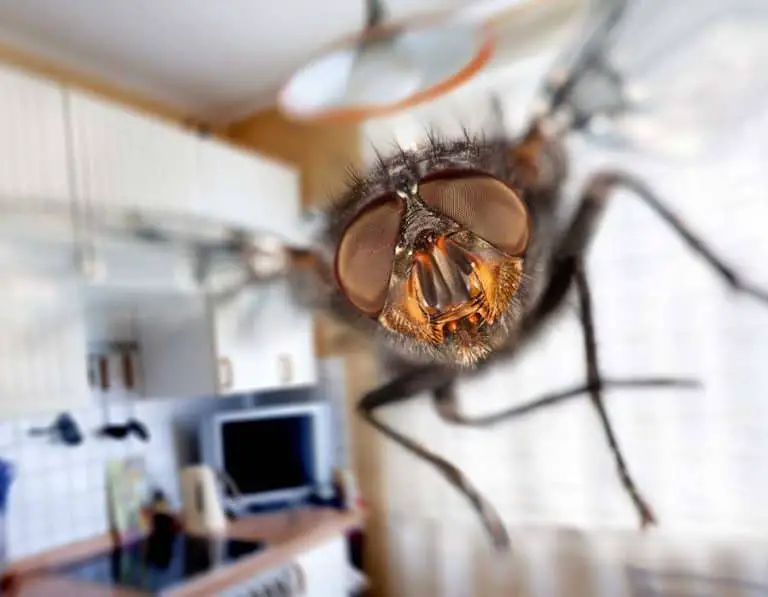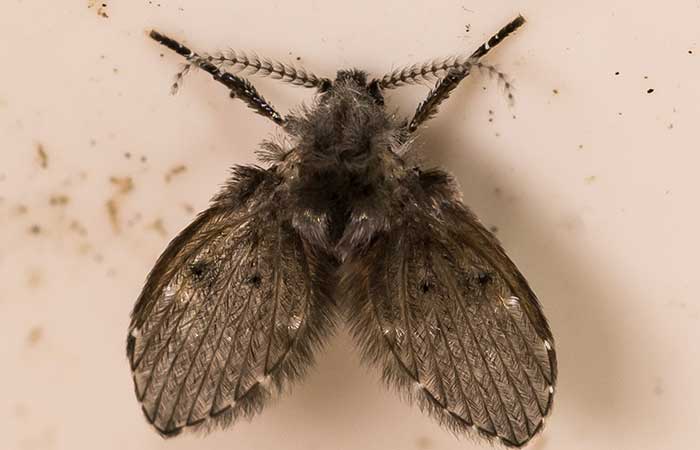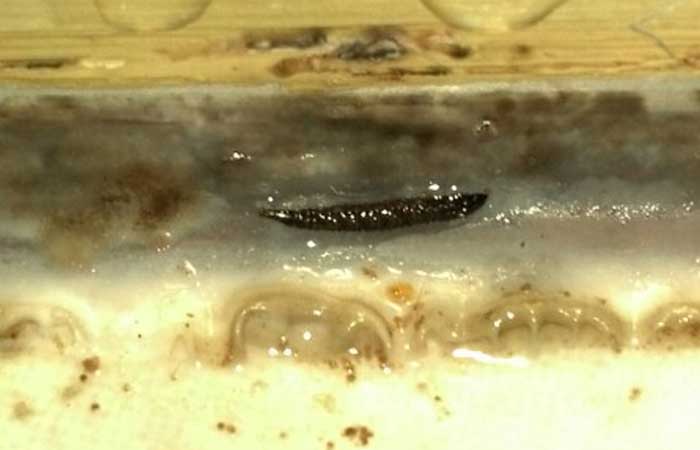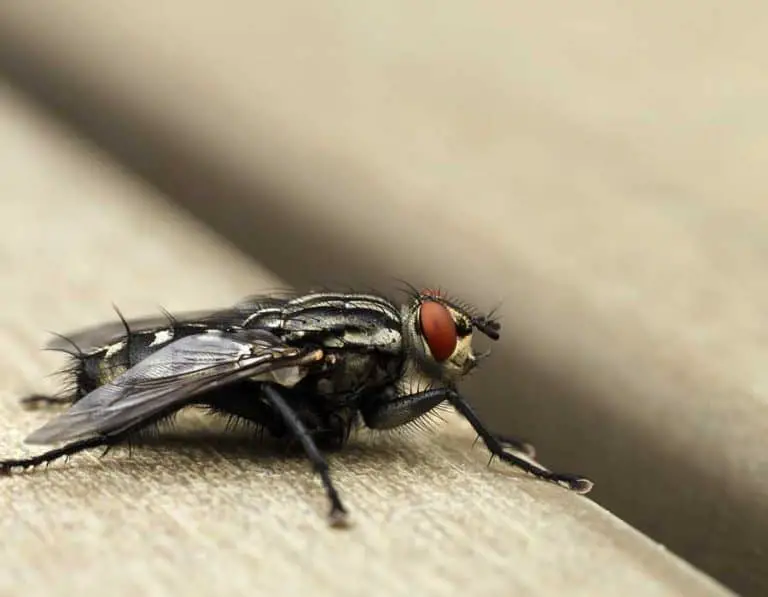Small Black Flies in Your Kitchen: How to Identify & Kill
Imagine sitting on a kitchen table ready to eat your food when suddenly you spot small flies buzzing on your food and around your cooking area. How would that make you feel? Small flies are generally not harmful, but they are still pests, and getting rid of them is the only way to enjoy your meals. However, there are different types of flies, and identifying their type is crucial before finding a way to kill them. So, if you aren’t an expert on flies, fret not.
This article will help you explore different types of small black flies so that you can fight against their invasion successfully. After all, no one likes uninvited guests in their kitchen, especially if they are a source of immense irritation.
Types of Small Black Flies in Your Kitchen
There are primarily four types of black flies, and any one of them might be invading your kitchen. So instead of panicking, look for some specific features and habits, so you know who your enemy is and how you can deal with it.
Drain Flies
Commonly known as sink or moth flies, drain flies look like moths and are often found near your drain. These pests reproduce within 48 hours, leaving you with an infestation that might be hard to control. Their larvae are commonly called drain worms and can be found around grime-filled, dark and moist areas of your plumbing.
Drain flies are between 2mm and 5mm, and they have these unique round bodies and wings like a moth. What’s more, they have a black or dull gray color that makes them stand out from the rest of the flies.
Moreover, their wings are pretty large and feature small scales. Also, they have large antennas with various segmented sections.
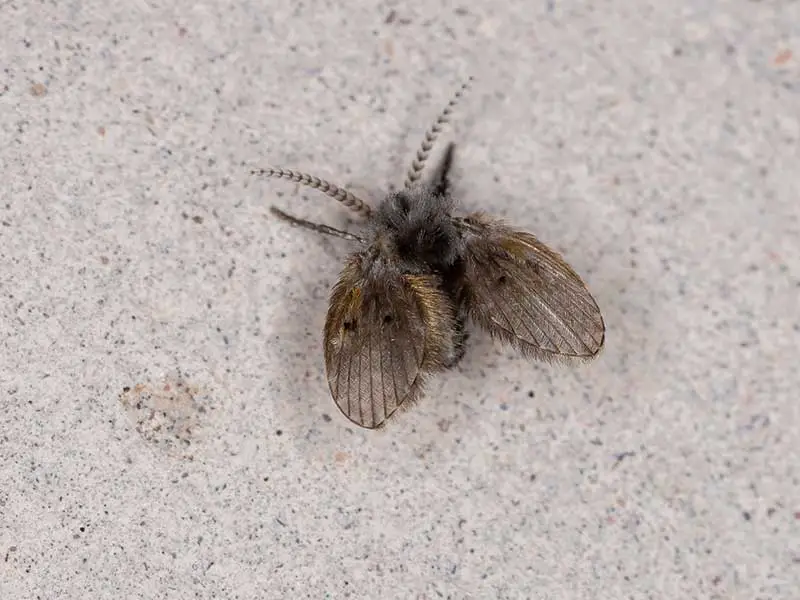
That said, one of the best ways to identify drain flies is through their limited flying capability. You can often find them making large hops rather than flying freely in your house. In addition, while drain flies can only live between eight and 24 days, they can easily produce around 300 eggs within two days, emphasizing the importance of killing them before they go out of control.
As stated above, you will mostly find these flies around the drain in your kitchen. However, you might also locate them relaxing on your kitchen walls or doors. Since these flies like moisture, they usually make their home around stagnant water, so your basement is also a common place for them to hang out.
Interestingly, they can easily breed in your air conditioner pipes, drain pipes, and in the covers of toilets and tanks used infrequently. In a nutshell, in areas with lots of shallow still water, you will see drain flies living happily and breeding fastly.
How to Get Rid of Drain Flies?
Since drain flies live in filthy areas, getting rid of them is the only way to save yourself from different issues. They won’t bite or hurt your home, but a large quantity of these flies can successfully create a nuisance.
If these flies are present in large quantities, the best way to deal with them is through professional intervention. However, if you can handle their number, both natural and chemical methods are available.
- Boiling water: Pour hot boiling water down your drain at least two times every day for a week. The water will help remove any buildup in the pipes that might be attracting these flies.
- Vinegar+Soap+Water+Sugar: Mix these ingredients in a tub, and place the mixture near the drain. Flies will get attracted to the sweet solution and will get trapped by the thickness of the soap.
- Plastic wrap and Apple cider vinegar: Take a jar and cover it entirely using plastic wrap. Fill the jar with a small quantity of vinegar and punch holes on top to allow the flies to enter but not leave.
- Drain cleaner: These flies often appear due to a clogged drain. Use good products to clean your drain and remove any accumulated residue.
- Use repellants and sprays: Use pest killers to kill drain flies. However, ensure that the product you go for is safe for kitchen drains.
Fruit Flies
Do you often see small “gnats” surrounding an overripe banana in your kitchen? Well, these are not gnats but fruit flies. They are pretty irritating plus not at all safe for your health. However, the good news is that you can easily get rid of them, provided you identify them on time.
Regardless of your location, you might find fruit flies in a trash can or on a kitchen counter. Besides, they might appear in every season but mostly during summer because they love rotten and ripe food.
Fruit flies look oval and can only grow up to 1/8th inch. While their abdomen appears black, the rest of the body has a tan color. Additionally, they have red eyes and hairless bodies, and wings.
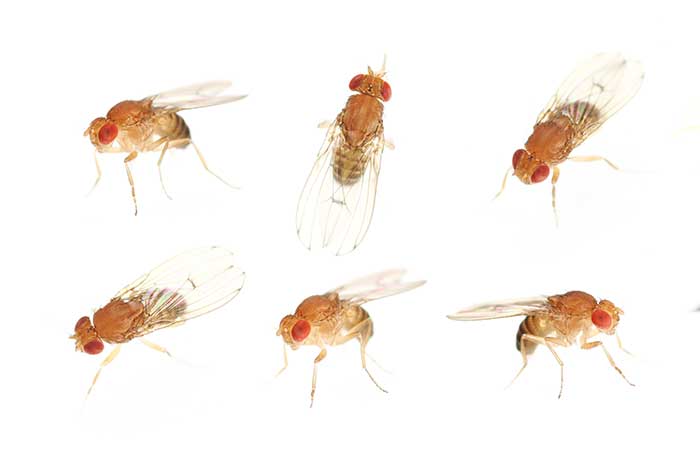
Once they grow up, fruit flies develop antennae, and their wings get thick intersections. However, one of the most significant properties of fruit flies is that they can lay at least 2,000 eggs on a moist surface. Also, within 30 hours, these eggs hatch, and the maggots grow in two days to mate again.
While this fly can only live for a maximum of 15 days, the reproduction process is so fast that you might see your kitchen filled with them in just a day.
Although fruit flies don’t bite, they can carry germs that might make you sick. They usually transfer bacteria such as listeria and salmonella, contaminating your clean food and also causing extreme food poisoning in some cases. And that is why it is best to get rid of them.
How to Kill Fruit Flies in Your Kitchen?
Here are some ways to eliminate fruit flies from your kitchen.
- Find their breeding ground: Locate and clean your kitchen for any rotten food particles. Besides, clean your counters, refrigerator, cabinet, and kitchen appliances that might be providing a home for these flies. Also, discard any empty cans or mops that you might not be using anymore.
- Clear any garbage disposal and drain: Pour some boiling water down the drain to clean it for any accumulated particles. Additionally, clean your garbage can every now and then to prevent fruit flies from growing.
- Dish soap and Apple cider vinegar: Mix these ingredients in a bowl, and place them near the flies. Vinegar will attract flies, but the soap will trap them.
- Bug spray: Use a bug spray, but ensure to check the ingredients. Keep all your fresh food away and make sure that your kids and pets are safe from the chemicals.
Phorid Flies
If the small black flies in your kitchen don’t look like any of the descriptions mentioned above but have a humped body, you might be a victim of phorid flies.
While phorid flies are tiny and their identification may be tricky, they have a few distinct features, such as flying and walking in an absurd pattern instead of a straight path. Moreover, you might find them mostly walking rather than flying in the air. Interestingly, these flies tend to run from their predators.
Phorid flies are primarily available near dead animals so you might find them near a mouse or rodent. These flies are similar to fruit flies and are yellow, brown, or black. But their larvae have shiny heads with a legless body, making them different from the rest.
Also, unlike fruit flies, phorid flies don’t have round eyes, nor do they like vinegar. And compared to drain flies, these flies don’t have fuzzy or moth-like bodies and are not too keen on dark or damp locations.
Phorid flies usually have a size between 0.5mm and 5.5mm. They are generally found attached to walls, plants, and even TV screens. They are often referred to as coffin flies or sewer flies.
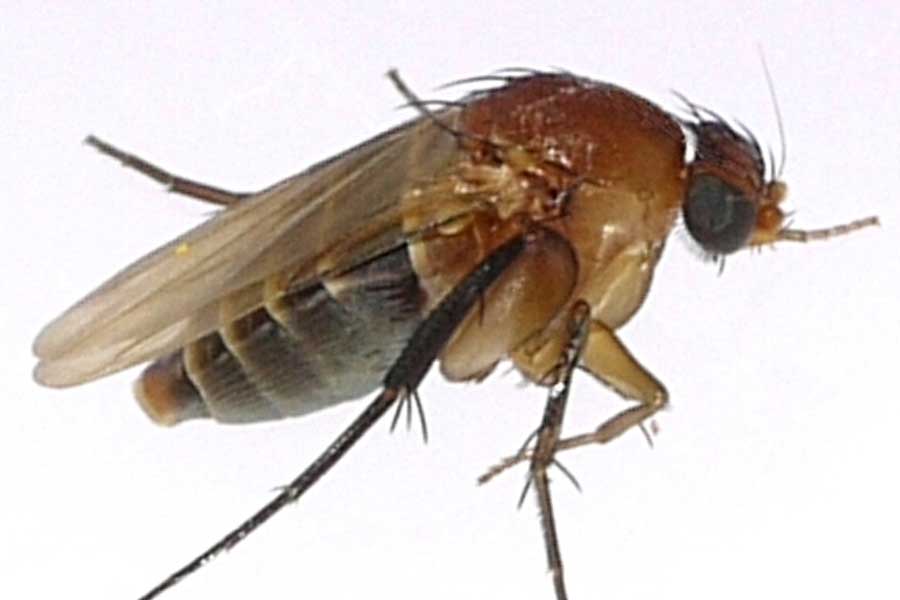
How to Kill Phorid Flies
Thankfully, killing these flies is not a big deal. You can easily get rid of them by following any of the four ways below:
- Eliminate any decaying matter: If you want to prevent or stop phorid flies infestation, look for any decaying matter in your kitchen and discard it as soon as possible. Search areas such as drains and garbage cans, and remove the breeding source of these flies as soon as possible.
- Use a pesticide: You can easily kill most adult phorid flies using a safe pesticide. Make sure to choose a product that contains pyrethrins that are safe for humans and pets.
- Sticky traps: People often use sticky strips and pads to trap these flies. Since they have a sticky wax-like material that also smells good, the flies stay trapped for a long time.
- Oil spray: An essential oil spray may also do wonders in some cases. Usually made with a blend of lemongrass, lavender, and eucalyptus oils, an essential oil mixed with some soap can help trap adult phorid flies easily.
Fungus Gnats
While you might usually take fungus gnats for granted, they can easily become a significant problem within a short time. Unfortunately, they can grow quickly, and their infestation can go out of hand.
That said, if you can identify these flies on time, you might save yourself and your family from a bigger disaster.
Fungus Gnats are usually found near indoor plants and get attracted by moisture. They can lay up to 200 eggs at a time and often breed on the soil’s surface. What’s more, adult fungus gnats only live for a week, but the small eggs take only two weeks to emerge from the soil and conquer an area like an adult fly.
It is very easy to identify fungus gnats. For instance, they have segmented antennae and skinny legs. Besides, they look pretty delicate, quite similar to a mosquito. They usually have gray wings and can have a body as long as 11/6 inches.
Fungus gnats can easily fly, but they prefer hopping from one place to another. Thankfully, these flies don’t spread diseases or bite humans. But they can pose a severe threat to your houseplants located in your kitchen area.
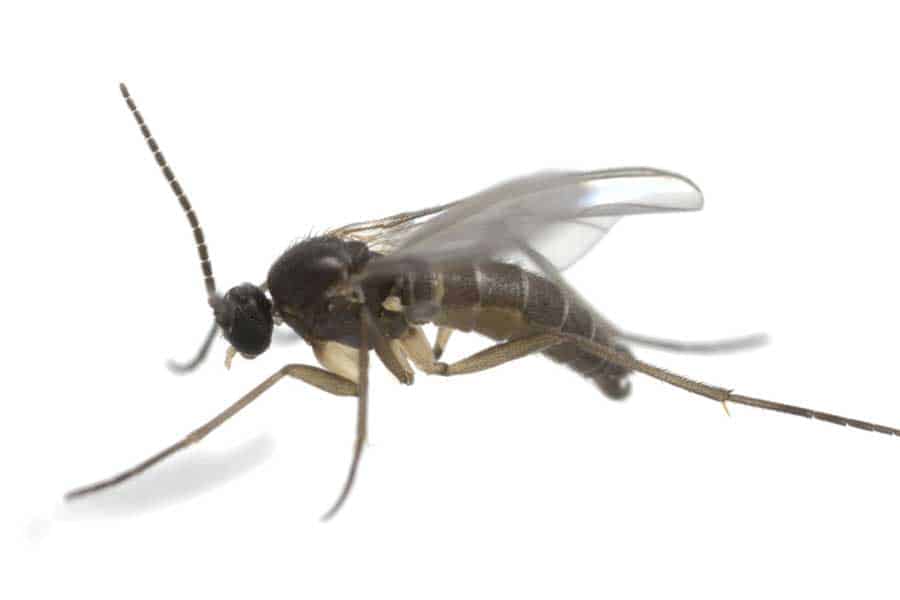
How to Get Rid of Fungus Gnats
Here are some ways to kill these flies and save yourself from any infestation.
- Use sticky traps: Sticky cards often have a wax-like material to trap these flies. For this remedy to work, make sure to use a dark and attractive colored trap, and remove it as soon as it does its job.
- Apple cider vinegar: Take a shallow container and add in water, vinegar, and some dish soap in a small quantity. Place the container near a plant with flies, and refresh the liquid solution every week.
- Use a chemical spray: If the above natural remedies fail to work, you can use a chemical spray and get rid of these flies. However, while choosing a product, make sure that it is safe for your food in the kitchen and not harmful to humans and pets.
Frequently Asked Questions
Here are some common queries and their answers on this topic.
Why Does My Kitchen Have So Many Small Flies?
There could be many reasons for this. That’s why first identify the type of these flies and then find the cause behind their occurrence. The most common reasons could be an uncleaned drain or leftover food in your kitchen.
Which Method Is the Most Effective to Deal With Small Flies?
The perfect method used to deal with flies depends on their distinct characteristics. However, many experts commonly use Apple cider vinegar, but it doesn’t work well with phorid flies.
Wrap Up
You can’t just sit here and let the small black flies invade your kitchen. They can cause nuisance, and some of them might also harm you. So, instead of waiting for them to leave on their own, identify their type and distinct characteristics, and apply different methods to get rid of them.
In an unfortunate case of heavy infestation, consult professionals and eliminate these pests for good.

